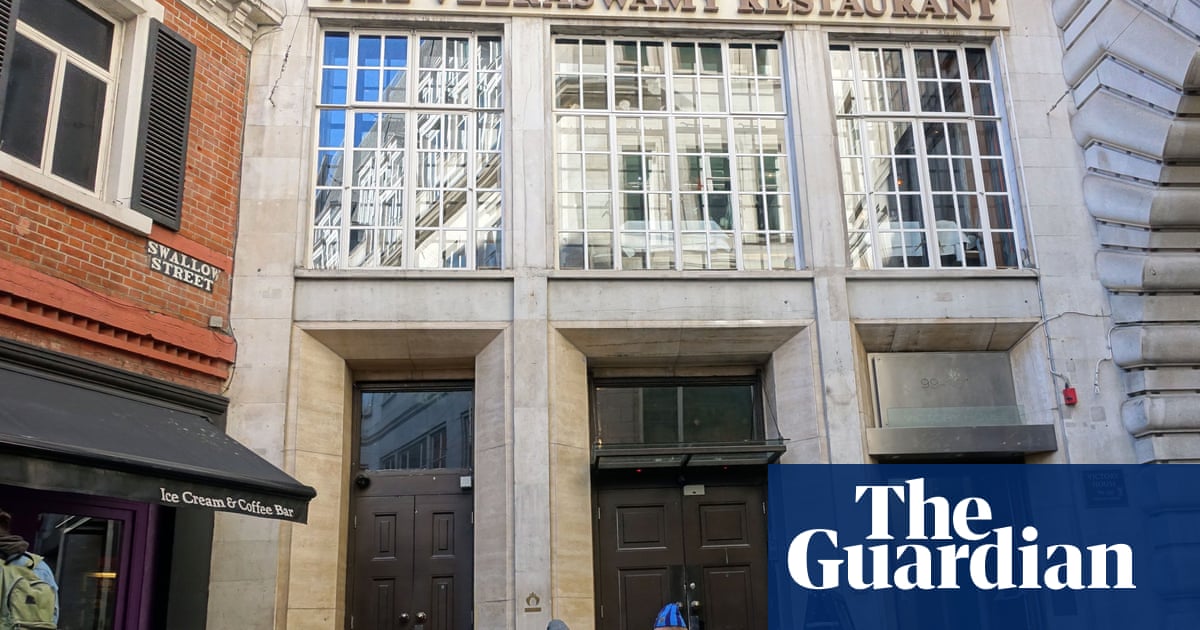When I arrange to meet Annabel Streets, the appropriately named author of a new book, The Walking Cure, I’m presented with a challenge. She wants me to choose a London location I am unfamiliar with, so I can experience her ideas about the upsides of urban landscapes. In the book, Streets contemplates the powerful impact walking can have on our mood, thoughts and emotions, and how this can differ according to where and how we walk. While most people are aware of the benefits of walking in nature, Streets makes the case for urban environments, known as “brown spaces” by developers. Surprisingly, churches, convents and cemeteries, all of which are found in cities, often offer a superabundance of wildlife. A study in one Berlin cemetery found 604 species, 10 of which were rare or endangered.
Streets believes it is in cities that our collective ingenuity is most obvious. I haven’t exactly been basking in astonishment lately, unless you count feeling astonishingly grumpy.
The trouble is, I have lived and worked in central London for decades and so I struggle to come up with anywhere new. Streets suggests we start at St Mary Aldermary, a City of London church I am unfamiliar with, near Mansion House tube station. The Christopher Wren edifice, rebuilt in 1682 following the Great Fire of London in 1666, looks unremarkable as I approach along a narrow street, fighting through hordes of City workers on their lunch breaks.
When I step across the threshold, I am astonished. Not only is it an architectural gem, it is also a cafe and community hang-out. People sit in the pews, typing away on laptops or contemplating the glorious stained glass.
“Isn’t it amazing?” says Streets. She looks pleased when I say I used to work a 10-minute walk away and never noticed the church. In fact, she has chosen it for a reason. Researchers have identified a wellbeing boost known as “the cathedral effect” which occurs when we have a lot of space above our heads. “That could be an expanse of sky, when you’re in a remote location or at the top of a hill,” says Streets. “But it could also be a cathedral or high-ceilinged church like this one. Researchers found that people had more empathy and compassion, and think more creatively, in such environments.” As we chat, I feel my shoulders drop and my mood lift.

Streets’ last book was called 52 Ways to Walk. It came about almost by accident when she was working on another project, Windswept, in which she explored the effect of landscape on creative women including Georgia O’Keeffe and Gwen John. In the process, she unearthed a trove of scientific research devoted to the benefits of walking.
What is it about walking that is so good for us? “Human beings were designed to walk and not just a stroll on a sunny day in a beautiful landscape,” she says. “When we walk, we produce biochemicals which are so powerfully life-affirming that scientists have described them as ‘hope molecules’”. You can gain the same effects from any other kind of brisk movement, but the great benefit of walking is you can do it pretty much anywhere and it doesn’t usually end in injury (I write as someone who has only recently completed running-related ankle rehab).
When Streets was growing up in rural Wales, neither of her parents drove, so walking miles was a necessity. Small wonder then that she now encourages people to consider walking in less than ideal conditions: in the cold, the rain, mud and – unthinkably – while hungry.
As a teenager, she rebelled and bought a Fiat which she drove everywhere, even to the gym. Walking was abandoned until her first year at university in Norwich. “I nursed my grandfather through cancer. I had barely settled into university and everyone else was out partying. After he died, it was really hard. And suddenly I found myself yearning for mountains. I had hardly been up a hill in my life. I took a year out and went walking in the Himalayas, the biggest mountains I could think of.”
After three months she came home, ready to return to her old life. “But why was I so desperate for mountains and why did they do me so much good? Some people say you yearn for the landscape you grew up in during times of trouble, but I grew up beside the sea. Then, when I was researching the book, I discovered that when we are at high altitudes, we produce a hormone called erythropoietin . That hormone is now being investigated as an antidepressant. So I look back at that period and wonder: did my body know what it needed?”
Does Streets have any theories about why walking outdoors should have a particular impact on our mental state? “Evolutionary biologists think it was once a survival mechanism – when we ran from danger, our brain had to be as efficient as our body. We needed to recognise our location, recall places of refuge, rapidly determine whether to climb a tree, change direction, pick up a rock, slow down or speed up. Escape has always required as much brain as brawn, as much intellect as speed.”
As part of social prescribing, some NHS Trusts now prescribe walking in nature as a way to help people improve their mental and physical health. But Streets is keen to raise awareness about the virtues of built-up environments.

“I love the opportunities for surprise,” she says, leading me out of the church, down winding backstreets. We walk past a bronze statue of The Cordwainer by Alma Boyes, its panel explaining the ward’s medieval roots as a centre for shoe-making. Further along, we see the dome of St Paul’s Cathedral looming up ahead. “Urban spaces are often much more stimulating and energising than more remote landscapes,” says Streets. “Unless marred by too much noise, pollution and traffic, cities can perk us up, pique our curiosity and trigger our imagination. Yes, you can walk in a park or through mountains and feel wonderfully calm, but there are few signs of human endeavour. Cities relax us as much, if not more, because humans are fascinated by each other and the things we have created. They encourage us to get out of our own heads and distract us from our own ruminating minds.”
We duck down a side street and peer through the window of Khops in Bow Lane. Founded in 1845, it claims to be London’s oldest barber. The patrons look back at us, bemused, so we beat a retreat, pausing to examine an intriguing sign outside a defunct bar. “The Four Sisters,” reads Streets. “I wonder who they were? That’s the thing about city walks – they are full of mysteries and adventures.”
She leads me down into the 11th-century crypt of another Wren church, St Mary-le-Bow. We linger, reading ancient inscriptions about the long deceased. It’s unnerving to contemplate these long-ago lives while the city thrums above our heads.
“Now open that door,” urges Streets. I push hard and stumble into a brightly lit room, narrowly avoiding a collision with a waiter bearing a tray of lunch. We are in the bustling Cafe Below and Streets looks gleeful. “You weren’t expecting that, were you?” she says, laughing. I begin to see what she means about the energising benefits of surprise. I experience a childlike thrill, like stepping into Narnia. It’s a feeling I haven’t had for a long time. When you have lived in the same place for ages, you can become jaded.
Streets tells me about a study which found that historical walks are as psychologically restorative and calming as green walks, if not more so. The research focused on the particular benefits of cultural heritage sites and how their aesthetics impact the brain.
She also flags up a related paper, which I find later. Sam Cooley, a psychologist at the University of Leicester, co-authored a study which echoed the finding that walks in green spaces do not appear to provide more benefits than urban walks. Rather, these walks provide different benefits at different times. “For example, two people may be wandering through a beautiful and remote nature reserve,” writes Cooley, “while not connecting with any of the surrounding wildlife, instead focused on the benefits of their social interaction. At the same time, another person may be walking the busy city streets and experience a connection with a single, resilient weed they spot growing in the concrete.”
This is all marvellous, of course, and I’m glad there is science to back up the fun we are having. But it is hard to imagine how I might allow myself the time and space to repeat the exercise regularly. What does Streets do herself? “I start each week by thinking, OK, what do I need this week? Do I need space? Do I need the comfort of trees? Do I need to be in a more enclosed space? Do I need to be near water? The more you learn to listen to your body, the more you will learn where your body wants to be. Do you want to be somewhere green, do you want to be somewhere historic? Do you want to be in the cemetery? I go to cemeteries a lot because you don’t always want to be in a happy place or mood.”

There is a whole chapter in Streets’ book devoted to walking in cemeteries. In any new place, she says, her first visit is usually to the local graveyard because they are a window into the culture and history of a community. “Among the headstones of history, we see ourselves as we are – a fleeting moment in the endless passage of time, a cluster of cells that, like everything else, will one day return to the earth. Whether we return from a cemetery walk with a feeling of gratitude, awash in gentle melancholy or with a fresh sense of purpose, is up to us,” she writes.
We take a quick look inside St Mary-le-Bow and marvel at how one person, Christopher Wren, could lay claim to the design of so many buildings. Then Streets leads me into the glass and chrome nightmare of the One New Change shopping centre, before we skirt round the gorgeous blossoms outside St Paul’s Cathedral and stroll down Fleet Street.
After an afternoon with Streets, I have experienced for myself the upside of a relaxed urban walk. Not only is this a gentler way to hit your daily step count than running, I do feel genuinely energised.
The good news is that if, like me, you are a fair-weather walker or unable to get outside for a stroll for any other reason, indoor walking still has clear benefits. Marily Oppezzo, now a behavioural and learning scientist at the Stanford Prevention Research Center, compared how walking on a treadmill or outdoors affects our creativity. Crucially, her study also compared walking with sitting still both inside and outside. Walking on a treadmill in a small room still achieved good results. In fact, any type of walking boosted people’s creativity by an average of 60% compared with not moving, no matter the location.
Streets and I end our walk on a bench in a tranquil square in the Inner Temple, one of the four Inns of Court. And yes, you guessed it, there is a study that reveals the cognitive benefits of strolling round urban squares …

 1 day ago
9
1 day ago
9













































